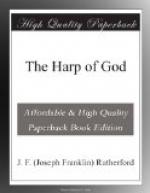[240]Charles then appears before the court which has entered the judgment against his brother John, and offers to pay the one hundred dollars which the law demands of John. The money is accepted from Charles and John is released. By this means John is judicially relieved from the effects of the judgment and is set free, and his brother Charles has become his ransomer or deliverer.
[241]In this illustration John represents Adam. Because Adam violated God’s law, Jehovah judicially determined that Adam should forfeit his life by dying. He enforced this judgment during a period of 930 years, during which time Adam begat all of his children. The effect of sentencing Adam to death was to render all of his children subject to death. Adam went into death, and since then great numbers of his children have likewise died. We can say, then, that Adam and all those who have died and are in their graves are in the great prison-house of death, and that is what the Prophet of the Lord calls it.—Isaiah 42:7.
[242]In this picture Charles represents Jesus. It was God’s will that the perfect man Jesus should redeem Adam and his offspring from the prison-house of death. Jesus was willing to pay Adam’s debt and redeem him, but the perfect, righteous, human being Jesus could not accomplish that purpose while living in the flesh, for the same reason that Charles could not use his strength, time, and energy to pay the debt of his brother John, but must first reduce those things to a purchasing value. Jesus must reduce his perfect humanity to a purchasing value, which we may call merit, and which merit or purchasing value would be sufficient for the payment of Adam’s debt and release Adam and his offspring from that judgment. In order to provide this price it was necessary for Jesus to die. In his death upon Calvary, then, he produced the price. But the value of that price must be presented before Jehovah in heaven itself before Jehovah could release Adam or his descendents from the effect of death. And this, we shall see from the Scriptures, is what was done.




